
Faculty Labs
News
What is ‘marine snow’? And how do microplastics slow the rate at which carbon is pulled from the sea surface to the depths?
It turns out plastics in the ocean do more than suffocate turtles, fish and other marine life.
A new study co-authored by Northeastern researcher Aron Stubbins shows that microplastics may reduce the ability of the ocean to help offset the climate crisis by slowing down the rate at which carbon is taken from the sea surface to the depths.
For millennia, the ocean has been part of a carbon sink process in which dead phytoplankton clump together and fall into the deep ocean in showers of what look like “marine snow,” says Stubbins, a professor of marine and environmental science.
The resulting carbon sequestration is a marine version of how trees and plants on terrestrial Earth take carbon from the atmosphere and store it in soil, he says.
But research by Northeastern shows that microplastics in the ocean are slowing the process down by making the “marine snow” more buoyant, Stubbins says.
“Plastics want to float. If phytoplanktons grow on microplastics in biofilms, instead of as free living organisms, that changes the buoyancy of the phytoplankton when they die,” Stubbins says.
“Basically, the plastics are slowing down the sinking rate of the marine snow, which is potentially reducing the efficiency with which the ocean can remove carbon dioxide from the atmosphere,” he says.
Read more from Northeastern Global News
Photo by Matthew Modoono/Northeastern University
Congratulations 2025 Tier 1 Award Winners!
Congratulations to the FY25 TIER 1 Award Recipients
This year, 25 cross-disciplinary teams have been chosen for highly competitive Tier 1 Awards, with 11 of these teams involving faculty from the College of Science.
TIER 1 Seed Grant/Proof of Concept Program awards are supported by the colleges, institutes, global campuses, and the Senior Vice Provost for Research. This program makes grants of up to $50,000 to support and encourage individual faculty members to form multidisciplinary teams to develop new and innovative research directions.
We’re immensely proud of the dedication of our faculty, staff, and students to collaborative, cross-disciplinary research efforts.
Machine Learning-Driven Optimization in the Synthesis of Sustainable Polymeric Foams
Diego Alzate-Sanchez (Chemistry), Miguel Fuentes-Cabrera (Computer Science)
A New Mathematical Paradigm for Integrating Stochastic Dynamic Modeling and Decision-Making under Uncertainty
Xuwen Zhu (Mathematics), Tong Ma (Mechanical and Industrial Engineering), Shahin Shahrampour (Mechanical and Industrial Engineering)
Mentored Award: Nanoparticle functionalized bioactive peptide for the resolution of inflammation
Emeka Okeke (Biology), Mansoor Amiji (Pharmaceutical Sciences/Chemical Engineering)
Mentored Award: Clarity in Complexity: AI-Human Teaming for Uncertainty Visualization of Multiple Forecasts
Lace Padilla (Computer Science, Psychology), Dakuo Wang (Art+Design, Computer Science)
Disentangling land and ocean signatures on greenhouse gas concentrations in coastal environments
Cristina Schultz (Marine and Environmental Sciences, Civil and Environmental Engineering), James Dennedy-Frank (Marine and Environmental Sciences), Khaled Ghannam (Civil and Environmental Engineering)
Socio-technical Considerations and Implications of Critical Mineral Extraction from Mining Waste
Damilola Daramola (Chemical Engineering, Chemistry), Laura Kuhl (SPPUA, International Affairs)
The shape of a university: exploring the collaborative networks of research universities
Dakota Murray (Network Science Institute), Alina Lungeanu (Communication Studies, Management and Organization Development)
QD-liposomes for real-time, whole animal particle tracking
Needa Brown (Physics), Allison Dennis (Chemical Engineering)
AI-Enhanced Vision-Based Privacy-Preserving Infant Sleep Safety Monitoring
Briana Taylor (Roux), Xiaolin Xu (Electrical and Computer Engineering), Michael Wan (IEAI), Sarah Ostadabbas (Electrical and Computer Engineering)
Advancing social media measurement to predict adolescent mental health
Alexandra Rodman (Psychology), Varun Mishra (Computer Science, Health Sciences)
Green Finance for Arctic Futures: Innovating for Sustainability and Indigenous Empowerment
Sara Constantino (Psychology, SPPUA), Mikhail Oet (CPS), Moira Zellner (SPPUA), Youngbok Ryu (CPS)
Photo by Alyssa Stone/Northeastern University
What’s in a name? A linguistics expert explains why some baby names dominate the charts year after year
What do names like Noah, James, Mateo, Mia, Evelyn and Luna all have in common?
They’re not only some of the top baby names in the United States, but they also seem to flow off the tongue. And that’s exactly why parents love them.
On May 10, the Social Security Administration released a list of the top baby names in the United States in 2023. Liam and Olivia maintained the number one spot in their respective categories for the fifth consecutive year while Noah and Emma also retained second place.
There’s a lot that goes into selecting a name for a baby. But looking at the overall list, Adam Cooper, a teaching professor and director of the Linguistics Program at Northeastern University, said many parents are picking names that avoid “hard stops” and instead flow off the tongue.
Read more from Northeastern Global News
Photo by AP
Northeastern’s Barnett Institute of Chemical and Biological Analysis celebrates 50th anniversary by looking to the future
The founder of Northeastern University’s Barnett Institute of Chemical and Biological Analysis made it clear that the institute’s 50th anniversary was as much a celebration of its future in cutting-edge research as a tribute to its past.
“You can’t be afraid of doing new things. Science changes so rapidly, each one of you is going to have to reinvent yourself multiple times,” Barry L. Karger said during an anniversary event last week at the EXP research complex on the Boston campus.
From the launch of the institute in 1973, Karger said, “We understood we’d have to keep inventing ourselves.”
In today’s world that means using algorithms, machine learning, advanced mass spectrometry and other tools to achieve the institute’s mission of measuring molecules to understand how they work in order to advance the field of analytical chemistry and biology.
“Who knows in five or 10 years,” said Karger, James L. Waters Chair and Distinguished Professor Emeritus.
“Karger’s vision was that understanding molecules was crucial to understanding where they could be used,” said Hazel Sive, dean of Northeastern’s College of Science.
Read more from Northeastern Global News
Photo by Matthew Modoono/Northeastern University



